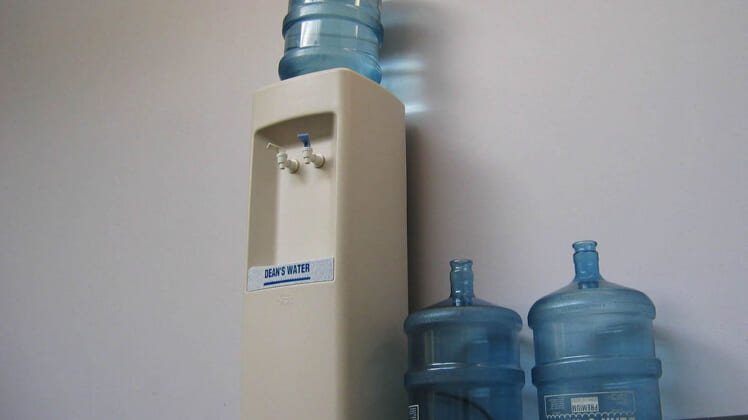
Trying to stay healthy this Spring?
You might be doing well with washing your hands and staying away from sick friends, but what about shared water coolers?
Generally, encouraging people to drink more water is a good idea, but water coolers have a knack for attracting germs. By using them, you might just be getting more than you bargained for.
The Problem With Water Coolers?
A germ-laden water cooler makes sense if you think about it. Co-workers or managers might not think twice about the last time it was cleaned or the bottle rotated.
Even if it were cleaned recently, a dozen or more coworkers can easily contaminate the entire supply by refilling used water bottles and touching the spigot with unwashed hands.
On top of that, there’s the cleaning process:
Unless an attendant cleans and disinfects each bottle thoroughly several times per week, you could find a number of germs inside that were missed entirely.
Needless to say, communal water coolers aren’t the most sanitary invention ever thought up.
Scientific Research On Water Coolers?
Although scientific research on water cooler sanitation is limited, one study in Iran realized its importance. The researchers took 32 samples from water coolers and 32 samples from tap water over a period of 5 months, and then analyzed the results.
While they tested a variety of areas from water pH to residual chlorine, the only significant factor that presented itself was the number of organisms in the water. Researchers found a total of 11 species of bacteria in the samples, and over 60 percent of the water coolers were contaminated with microorganisms beyond acceptable levels.
Specifically, the researchers measured the heterotrophic plate count (HPC) in the water. This measurement is standard for water quality and assesses the number of heterotrophs in the water. Heterotrophs are microorganisms that grow in organic carbon, and they can include bacteria, yeast, or mold.
Only a small amount is considered acceptable in normal drinking water. The results of this study, which showed unsafe HPC levels in water coolers, should definitely be a huge concern for public safety.
The Healthiest Part of an Avocado
What’s In Your Water Cooler?
Outside of bacteria and HPC organisms, water coolers can have other contaminants inside them too.
1. Chemical Residue
The cooler has to be cleaned regularly to keep it safe, but most cleaning processes include using bleach or chlorine. As in other water sources, these chemicals are used to kill bacteria.
However, they have to be thoroughly flushed through the system to make sure that no residue is left. If you ever come across a cloudy or off-tasting water cooler, you should notify someone in charge right away. The cooler may need to be rinsed further for everyone’s safety.
2. Algae
All that algae need to grow is a damp environment and some sunlight. Under the right circumstances, even fluorescent light can cause it to grow.
Unfortunately, all these factors can describe your office water cooler. As a prevention, the office may need to periodically test the water for algae and clean it appropriately.
3. Water Cooler Illnesses
As you might expect, your office’s contaminated water cooler can pose a health dilemma for you and your coworkers.
You might enjoy the convenience of accessing water in the office, helping you drink more, but is it worth the risk? You might even become ill from the germs and bacteria lurking inside.
One species of bacteria that grows in warm, moist environments can cause several severe illnesses. For example, a person could contract Legionnaires’ disease, which starts out with flu-like symptoms and then quickly progresses to a dangerous form of pneumonia.
In the beginning, your symptoms might include:
- A slight fever
- Aching joints
- Fatigue
- Loss of appetite
Once the pneumonia symptoms settle in, they may progress to:
- High fever
- Dry then productive cough
- Shortness of breath
- Chills
- Chest pains
The disease occurs when a person drinks water contaminated with the LDB bacteria and accidentally inhales the water or otherwise breathes the bacteria into the lungs.
According to the Occupational Safety and Health Administration, 10,000 to 50,000 cases of Legionnaires’ disease occur in the United States every year.
Another illness caused by these bacteria is Pontiac fever, which produces flu-like symptoms. Pontiac fever usually lasts several days and has never ended in death.
Other than these illnesses, you can easily contract common viruses and colds from a water cooler because of the number of people using it every day.
What Causes Bad Breath?
The Water Cooler Solution
To avoid the bacteria and illnesses surrounding a traditional water cooler, you really only have two options. First, office personnel should have stringent policies regarding cleaning and using the water cooler, and they should work to enforce these policies as much as possible.
1. Proper Water Cooler Cleaning
Personnel should make sure to wash their own hands before handling the cooler and use the appropriate amount of cleaner and chemicals inside the water bottle and spigot area. Then, they should make sure to flush the bottles and spigot through with water until there’s no question of residue left behind.
2. Procedure For Using The Water Cooler
- Coworkers should wash up beforehand and only use clean water bottles to fill up at the spigot.
- They should not touch the spigot area as much as possible and should never take a drink directly from the spigot itself.
- When changing the water bottle or handling any part of the water cooler, they should also wash their hands.
- Then, when handling the bottle, they should take care not to touch the bottle’s neck, a part that comes into close contact with the dispensing system.
Now, if you know anything about office enforcement, such a stringent set of rules can be difficult to hold to. For that reason, your office may need to consider a bottle-less solution with built-in sanitation or water purification.
Conclusion
Whichever way your work environment goes, you should at least be aware of the hazards involved with a water cooler.
Because of its contact with many people, you may risk illnesses like the flu or even Legionnaires’ disease.
At your work, you could be the voice of reason helping people understand water cooler etiquette or pushing for a better option.

